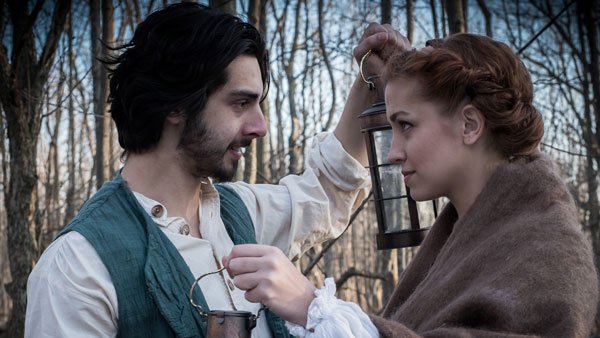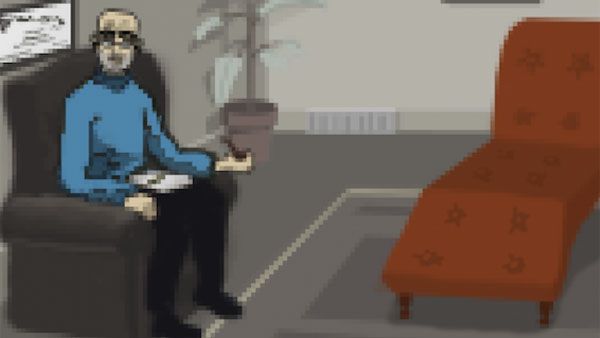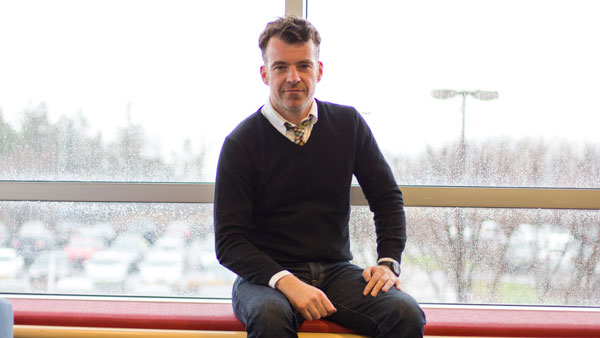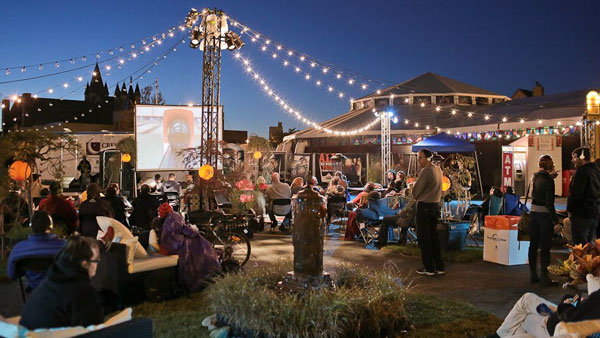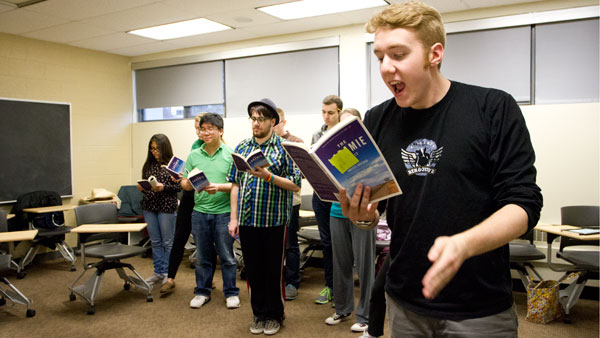Portraits of a man zippered into the borrowed skin of his photographic subjects line one of the walls of the Handwerker Gallery. The man depicted in the center piece stares straight into the camera, posing seductively as he grips a half-filled wine glass loftily in one hand. It takes a second to realize that the V-shaped zipper exposing his hairy chest connects the man’s head to a topless woman’s body.
These images are part of artist Sean Fader’s collaborative, identity-bending photographic series “I Want to Put You On.” His works are featured in the Handwerker Gallery’s newest exhibit, “Strange Bedfellows,” which contains art in a variety of mediums that all explore modes of identity and collaboration to promote LGBT awareness. The exhibit is a joint effort between the Handwerker Gallery and students in Professor Keri Watson’s 300-level art history course, Museum Practices and Methods.
Senior Amanda Suarez, art major and employee at the Handwerker Gallery, said in relation to some of the other exhibits she has worked on, “Strange Bedfellows” really pushes conceptual boundaries.
“In my time here, there hasn’t really been an exhibit like this before … it’s refreshingly controversial,” Suarez said.
While past exhibitions this year have expressed environmental, formal aesthetic or authorship concerns, a portion of “Strange Bedfellows” touches on a topic directly related to the sexual orientation and gender identity of the Ithaca College community. For many, the language of identification is unknown, which marginalizes community members that do not classify themselves as cisgendered, individuals who identify with the gender they were at birth, heterosexuals.
Sophomore Matt Dankanich and Ithaca resident Stanislav Terisova sat laughing at a small television set as they watched the series finale of the second season of “Falling in Love … with Chris and Greg,” a sitcom created by queer-couple Chris Vargas and Greg Youmans.
The episode, titled “Cheesecakes and Memories,” depicted the commonplace challenges of a day in the life of a cisgender gay man and his transgender male partner. The pair still deals with conflicts typical of any relationship, in addition to the societal obstacles faced by queer couples.
This video, along with other pieces in the exhibit, offers a candid look at the lives of queer couples and individuals and helps demystify an increasingly relevant topic. While the show tackles hot-button issues in the queer political arena, such as marriage equality, Proposition 8 and pregnant men, Dankanich said the Web series is easy for a diverse audience to relate to.
“It takes these issues out of the bedroom and off the dinner table to open a window into [Chris and Greg’s] lives,” Dankanich said. “The real issue here isn’t gay marriage, it’s whether or not they want to have kids or what kind of tea they like to drink.”
Junior Andrea Millares thinks the exhibit helps educate and dispel previous assumptions about queer identities.
“Those that aren’t very familiar with the queer community will be enlightened by this eye-catching, politically charged exhibit,” Millares said.
Many of the pieces within the travelling exhibition highlight a creative partnership or collaborative effort between artists and sometimes even non-artists. Artist couple Tina Takemoto and Angela Ellsworth created a series of photographs titled “Imag(in)ed Malady.” Blackened, burned out matchsticks are taped onto a woman’s arm, fully covering it in one of the photographs Takemoto took for Ellsworth.
When Ellsworth was diagnosed with Hodgkins disease, she would send Takemoto documentation of the injurious physical effects of her medical treatment. Takemoto would send “rhyming” photographs in response, recreating various effects on her own body in a darkly humorous manner. For example, Takemoto would stain the tops of her feet with blue pixie sticks to mimic the effect of the dye injections Ellsworth received during treatment.
Other artists, like Sarah Hirneisen, collaborated with a non-artist to create her piece titled “My Sister Natalie.” In this project, Hirneisen altered her family history by refashioning early photographs and keepsakes to give her transgender sister, Natalie, the childhood she always wanted. The creation of the piece required input and support from Natalie, particularly on a conceptual level, though Hirneisen produced the physical artwork itself.
The collaborative process between the sisters, similar to the photographic dialogue between Ellsworth and Takemoto, helped develop an informed perspective through mutual experience, Suarez said.
“[I think] the collaboration seemed to help the artist and her sibling [reconcile] the big change in the family,” Suarez said.
Pieces like Billy O’Callaghan’s “yet another gift from our sun” — a series of rainbows that shift in color, printed on cardstock and folded like an accordion — were inspired by other sorts of collaboration. When O’Callaghan’s mother moved in with him and his partner, the elderly woman’s memory began to dangerously decline. Therefore, O’Callaghan invited his elderly mother to assist him with the production of his zine artwork.
Sophomores Sarah Gervais and Cassie Walters giggled as they attempted to play with the folded piece as instructed. Holding each end of the small accordion of images in opposite hands and moving it like a slinky toy helps produce a meditative effect on the participant. The piece is meant to invite the interaction of visitors, encouraging them to collaborate by providing templates and instructions for creating their own accordion zines.
With the advent of the new museum studies concentration within the art history department, the Museum Practices and Methods course has evolved to give students more practical, hands-on experience, whereas previous iterations of the class focused more on theoretical museum studies. Students completed condition reports for displayed objects and worked together to promote some of the visiting featured artists.
“Although [Museum Practices] is not a new class, this is the first collaboration [where] students help produce an actual show,” Watson said.
Students will also introduce Amos Mac, self-publisher of trans quarterlies Original Plumbing and Translady Fanzine, at 6 p.m. March 27 in the gallery. Mac is the artist behind the exhibit’s photographs of drag queen Juliana Huxtable Ladosha, who will soon be featured in the second issue of Translady Fanzine.
“Strange Bedfellows” provides a space for constructive dialogue about paradigm shifting and representation in regards to queerness as both an expression of gender identity or sexual orientation and as a sociopolitical stance that deviates from sociopolitical norms. Millares said the gallery’s choice to house an exhibit that expands on such a marginalized subject matter has definitely struck a chord with visitors.
“I think it’s about time the Handwerker presented something like this [since] Ithaca College has such a strong queer community … It feels like our voice is finally being heard,” Millares said.






